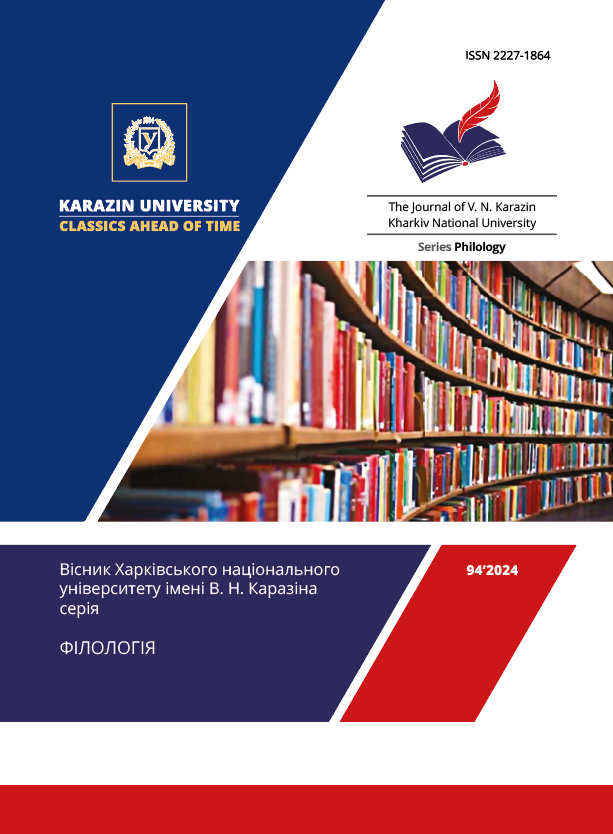«Від звіриного до людського»: неоміфологічні реінтерпретації образу Даліли в російській літературі межі XX–XXI століть
Анотація
У статті в діахронічному аспекті розглядається один із вічних образів світової культури, а саме інтерпретація та реінтерпретація образу Далили в російській літературі, перш за все, в поезії, починаючи з 19 століття і до наших днів. Новаторство статті пов'язане із запровадженням у науковий контекст цілої низки неоміфологічних текстів та їх коментування, а також вивченням поетики міфу та неоміфу з акцентом на етичному аспекті у руслі ідей Дмитра Овсянико-Куликовського.
Актуальність поставленої мети пов’язана з можливістю вирішити кілька взаємопов’язаних наукових завдань, оскільки функціонування міфологічних образів та біблійних сюжетів, а саме вектор концептуалізації їх смислів, не тільки дає змогу зрозуміти специфіку культури сприйняття, але й дозволяє судити про моральний стан суспільства.
У ході проведеного дослідження були виявлені наступні тренди в рецепції сюжету: послідовне зміщення інтересу російських авторів з фігури Самсона до Даліли, зміна в системі персонажів та способу нарації, зміна модальності образу Даліли, її трансформація у переважно ідилічну героїню. Особливу увагу в статті приділено політичній концептуалізації образу Даліли, що пов’язано з включенням сюжету в так званий перукарський текст російської літератури та культури.
Автор статті дійшов висновку, що у сучасних неоміфологічних реінтерпретаціях образ Далили стає концептуально двоїстим. У любовній ліриці простежується гуманізація образу Далили, її еволюція від звіриного до людського. У соціальній поезії переакцентування уваги авторів із Самсона на Далілу призводить до посилення її ролі у вічному сюжеті, перетворенню на політично ідейну вбивцю. Проведене дослідження може бути також цікавим і в аспекті гендерних досліджень, оскільки залучений матеріал дає підставу розглядати образ Далили в сучасній російській літературі як одну з репрезентацій фатальної жінки.
Завантаження
Посилання
Aleksandrov, A. (2014 May). “An era with a human face...” Volga. https://magazines.gorky.media/volga/2014/5/vesna-zanaveshena-tyulem-8230.html
Bobishev, D. (2005 April). “Episode”. Novij mir. https://imwerden.de/pdf/novy_mir_2005_04__ocr.pdf
Buhks, N. (2008). “Barber Code” in Russian Culture of the 20th Century”. Interpretation and Avant-garde: Collection of Scholarly Articles. Edited by Igor Loschilov. Novosibirsk: Printing House of Novosibirsk State Pedagogical University. https://raspopin.den-za-dnem.ru/pic-00004/2021-pdf/Inter-avangard.pdf
Cvetayeva, M. (1922). The Maiden Tsar. Moscow: State Printing House. P.64.
Elagina, E. (2009). Within Sight. Saint-Peterburg: Zvezda.
“Eternal” Plots and Images in Literature and Art of Russian Modernism, (2015). Edited by Andrey Toporkov. Moscow: Indrik.
Grigorjeva, L. (2007 September). “Samson and Dalilah”. Zvezda. P. 73.
Ilyushin, A. (2009 March). “Two Long Poems by Yu. F. Sidorin (“Michele Trivolis” and “The Good Vampire”)”. Humanities research in Eastern Siberia and the Far East. Pp. 74 – 85.
Kanevskij, G. (2014 Nr 43). “here come ivan and danila...” Novij bereg. https://magazines.gorky.media/bereg/2014/43/stihotvoreniya-186.html
Ken, L. (2008). “Samson in Chains” by Leonid Andreev: From Concept and Variants to Text”. Proceedings of the St. Petersburg State Institute of Culture. Pp. 29 – 43.
Kozanogin, S. (2011). “Interpretations of the Image of Samson from the “Book of Judges” in Russian Literature of the XIX - Beginning of the XX century”. Materials (Izvestiya) of the Volgograd State Pedagogical University. Pp. 105 108.
Kudimova, M. (2011). “The Echelon”. The Turn. Novosibirsk. Poetry library of the magazine “Siberian Lights”.
Leontjev, A. (2012 February). “Samson in Peterhof”. Novij mir. https://magazines.gorky.media/novyi_mi/2012/2/molochnyj-brat.html
Literature and Religion. A Collection of Scientific Papers, (2010). Edited by Ieva Kalniņa. Riga: Jauna Daugava.
Literature and Religion. A Collection of Scientific Papers. Saints and Sinners (2018). Edited by Ieva Kalniņa. Riga: Academic Press of the University of Latvia.
Ovsyaniko-Kulikovsky, Dm. (1989). Literary Critical Works. In 2 volumes. Vol. 2. From the “History of the Russian Intelligentsia”. Memories. Moscow: Khudozhestvennaya literatura.
Petrovykh, M. (1955). “The wind howls, the wind whistles...”. https://libverse.ru/petrovuh/veter-voyet-veter-svishchet.html
Sakson, L. (1999). Sakson and Dalilah. http://leonid-sakson.com/index.php/poeziya
Shiryayev, A. (2008 March). “At the Entrance of the Harbor”. Deti Ra. https://reading-hall.ru/publication.php?id=286
Stepanov, N. / Klementc, N. (1901). A Little Bit of Everything. Moskow: Printing House of G. Lissner & A. Geshelj. P. 32.
Vassilyeva, E. (2007). “The Body Language in “Samson Nazorei” by V. Zhabotinsky”. Proceedings of the Sefer Center. Scholarly Conferences in Jewish Studies. Part III. Pp. 248 – 258.
Voyvodich, Y. (2021). Neo-Mythologism in Contemporary Russian Prose. Moscow: Flinta.
Weisskopf, M. (2008). “Road to Gaza: Vladimir Zhabotinsky and the Search for Plot in the Theory and Practice of the Russian Avant-garde”. Interpretation and Avant-garde. Edited by Igor Loschilov. Novosibirsk: Printing House of Novosibirsk State Pedagogical University. https://raspopin.den-za-dnem.ru/pic-00004/2021-pdf/Inter-avangard.pdf
Zastyrets, A. (1999, 2003). “Didn’t you know, eh, Delilah?” Anthology of modern Ural poetry. Chelyabinsk: Printing House “Fond Galereya”. Vol. 2 (1997 – 2003).




